There are few geographic features in Arkansas more iconic than the Mississippi River. Every creek, stream, or river in the state, no matter how large or small, is ultimately a part of the Mississippi River basin. It is also critically important in terms of the state’s aquatic biodiversity. There are a number of aquatic species found there that do not make it far, if at all, up into tributary streams. Which explains my excitement when I discovered something last month while conducting aquatic trapping surveys along the Mississippi.
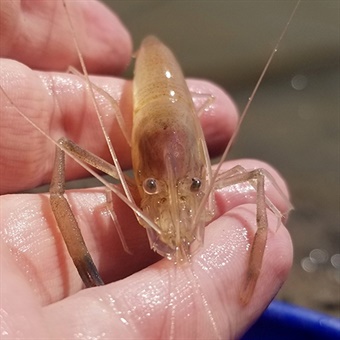 When I pulled up one of my traps, I found myself face-to-face with an animal that I had never seen before outside of photographs. It was a crustacean about the size of a crayfish, but I knew right away that it was something very different. It had a pair of slender, delicate pincers, which upon closer inspection were at the tips of its greatly elongated second pair of legs, rather than the first. Its body was streamlined and semi-translucent, and its upward-pointing rostrum (“nose”) was covered in a row of prominent saw-like teeth. I knew I was looking at one of the most unique and elusive aquatic species in Arkansas, the Ohio Shrimp (Macrobrachium ohione), which was high on my dwindling bucket-list of aquatic species in Arkansas that I have not yet seen. As I pulled up my other traps, I realized I had actually caught several of these fascinating creatures.
When I pulled up one of my traps, I found myself face-to-face with an animal that I had never seen before outside of photographs. It was a crustacean about the size of a crayfish, but I knew right away that it was something very different. It had a pair of slender, delicate pincers, which upon closer inspection were at the tips of its greatly elongated second pair of legs, rather than the first. Its body was streamlined and semi-translucent, and its upward-pointing rostrum (“nose”) was covered in a row of prominent saw-like teeth. I knew I was looking at one of the most unique and elusive aquatic species in Arkansas, the Ohio Shrimp (Macrobrachium ohione), which was high on my dwindling bucket-list of aquatic species in Arkansas that I have not yet seen. As I pulled up my other traps, I realized I had actually caught several of these fascinating creatures.
Arkansas is home to two very distinct species of freshwater shrimp belonging to the family Palaemonidae. Shrimps are decapod (“10-footed”) crustaceans that move primarily by swimming. They have elongated, slender bodies and thin, delicate legs. They differ from the much more commonly encountered crayfish (which belong to a different family of decapods, Cambaridae) in being fully aquatic, having weaker legs used more for perching than walking, having a tail flattened from side-to-side rather than top-to-bottom, and having an overall more slender build.
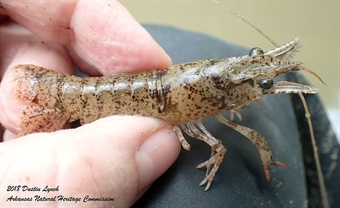 Furthermore crayfish and shrimp differ in their primary form of locomotion. While crayfish are capable of swimming in powerful, brief bursts to evade predators, they tend not to travel far using this method, instead preferring to crawl along the bottom with their more well-developed walking legs. Crayfish frequently lose and regrow their chelae (claws), and it is not uncommon to encounter crayfish missing both chelae entirely or with very small, developing claws. There is even a species found in some lowland portions of the state known as the Shrimp Crayfish (Faxonius lancifer) which somewhat resembles a shrimp due to its very small, slim claws and elongated rostrum.
Furthermore crayfish and shrimp differ in their primary form of locomotion. While crayfish are capable of swimming in powerful, brief bursts to evade predators, they tend not to travel far using this method, instead preferring to crawl along the bottom with their more well-developed walking legs. Crayfish frequently lose and regrow their chelae (claws), and it is not uncommon to encounter crayfish missing both chelae entirely or with very small, developing claws. There is even a species found in some lowland portions of the state known as the Shrimp Crayfish (Faxonius lancifer) which somewhat resembles a shrimp due to its very small, slim claws and elongated rostrum.
-dustin-lynch.jpg?sfvrsn=de3fb2a4_0&MaxWidth=340&MaxHeight=400&ScaleUp=false&Quality=High&Method=ResizeFitToAreaArguments&Signature=F28E8777077691CCCA8E60B3CE82490709846043) Other crustaceans in Arkansas sometimes mistaken for shrimp are amphipods, commonly known as scuds. Most scuds are extremely small (less than a half-inch in length), strongly laterally compressed, and lack the distinct carapace found in decapods.
Other crustaceans in Arkansas sometimes mistaken for shrimp are amphipods, commonly known as scuds. Most scuds are extremely small (less than a half-inch in length), strongly laterally compressed, and lack the distinct carapace found in decapods.
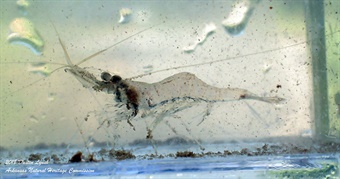 By far, the diminutive Mississippi Grass Shrimp (Palaemonetes kadiakensis) is the most commonly encountered of the two shrimp species in Arkansas, and is found in a variety of aquatic habitats throughout the lowland regions of the state. It can be abundant in the sluggish waters of bayous, sloughs, swamps, backwaters, and oxbows, particularly in areas with ample aquatic vegetation. Grass Shrimps are translucent, sometimes nearly transparent, often with green vegetation visible inside their digestive systems. In gravid females, the tiny eggs are clearly visible through the body wall. The eyes are large and darkly pigmented and the abdomen has a distinctly humped appearance. This species reaches a maximum size of less than 2 inches, although many individuals encountered will be much smaller than that. Grass Shrimps feed primarily on algae but may consume other plant matter and occasionally small aquatic insects and detritus.
By far, the diminutive Mississippi Grass Shrimp (Palaemonetes kadiakensis) is the most commonly encountered of the two shrimp species in Arkansas, and is found in a variety of aquatic habitats throughout the lowland regions of the state. It can be abundant in the sluggish waters of bayous, sloughs, swamps, backwaters, and oxbows, particularly in areas with ample aquatic vegetation. Grass Shrimps are translucent, sometimes nearly transparent, often with green vegetation visible inside their digestive systems. In gravid females, the tiny eggs are clearly visible through the body wall. The eyes are large and darkly pigmented and the abdomen has a distinctly humped appearance. This species reaches a maximum size of less than 2 inches, although many individuals encountered will be much smaller than that. Grass Shrimps feed primarily on algae but may consume other plant matter and occasionally small aquatic insects and detritus.
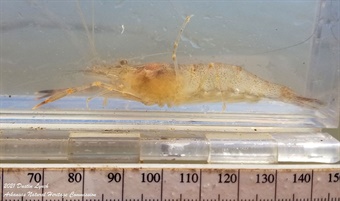 The much rarer of the two shrimp species in Arkansas is the Ohio Shrimp (Macrobrachium ohione), considered critically imperiled in the state. This species is considerably larger than a Grass Shrimp, attaining a maximum length of more than 4 inches, not counting the length of its appendages, including the prodigiously elongated, pincer-tipped second pair of legs. Females are considerably larger than males. The rostrum of this species is topped with nine to 13 prominent, saw-like teeth (as opposed to the six to eight such teeth present in a Grass Shrimp). It is pale gray in color, flecked with specks of darker pigment. This is a species of our largest rivers, where it can typically be found in side channels or the edges of the main channel.
The much rarer of the two shrimp species in Arkansas is the Ohio Shrimp (Macrobrachium ohione), considered critically imperiled in the state. This species is considerably larger than a Grass Shrimp, attaining a maximum length of more than 4 inches, not counting the length of its appendages, including the prodigiously elongated, pincer-tipped second pair of legs. Females are considerably larger than males. The rostrum of this species is topped with nine to 13 prominent, saw-like teeth (as opposed to the six to eight such teeth present in a Grass Shrimp). It is pale gray in color, flecked with specks of darker pigment. This is a species of our largest rivers, where it can typically be found in side channels or the edges of the main channel.
Perhaps the most fascinating thing about the Ohio Shrimp is its complex life history. This species is a long-distance migrant that must travel, often hundreds of miles, from its home in rivers to coastal waters in order to reproduce. Aquatic species that migrate between fresh water and the sea exhibit a life cycle known as diadromy. Diadromy can be further divided into several classifications, the most well-known being anadromy and catadromy. Anadromous species (such as salmon) migrate from the sea into freshwater to spawn, while catadromous species (such as eels) conversely migrate from freshwater to the sea to spawn. The Ohio Shrimp exhibits an even more complicated form of diadromy known as amphidromy, in which adults migrate to the lowest portions of rivers that empty into the ocean to reproduce near the coast. The larvae drift into the marine environment where they spend the first part of their lives growing in coastal waters; in fact, saltwater is necessary for somatic growth in the young of this species. After developing to a certain stage, the juvenile shrimp experience a strong rheotaxis, i.e. a response to the stimulus of a river current in which an organism is compelled to swim upstream. The shrimp then travel sometimes hundreds of miles up rivers to live out their lives far from the coast.
-d-lynch.jpg?sfvrsn=7a226354_0&MaxWidth=340&MaxHeight=400&ScaleUp=false&Quality=High&Method=ResizeFitToAreaArguments&Signature=8511DE734A124085331A2F8B8AE1F07522056352) At one time, the Ohio Shrimp could be found throughout most of the eastern United States. It could be found in the Mississippi River basin from the Gulf Coast to the upper reaches of the Ohio River, and also in rivers along the southern Atlantic coast. The species was historically so abundant throughout much of the Mississippi River that it supported inland commercial shrimping industries in several states, where it was collected both for bait and human consumption, a practice that still persists in a few areas. Although historical accounts of the species in Arkansas are somewhat scarce, there is evidence that it once ranged as far up the Arkansas River as Fort Smith and may have been found throughout much of the Red River as well.
At one time, the Ohio Shrimp could be found throughout most of the eastern United States. It could be found in the Mississippi River basin from the Gulf Coast to the upper reaches of the Ohio River, and also in rivers along the southern Atlantic coast. The species was historically so abundant throughout much of the Mississippi River that it supported inland commercial shrimping industries in several states, where it was collected both for bait and human consumption, a practice that still persists in a few areas. Although historical accounts of the species in Arkansas are somewhat scarce, there is evidence that it once ranged as far up the Arkansas River as Fort Smith and may have been found throughout much of the Red River as well.
Unfortunately, the Ohio Shrimp has drastically declined across much of its historic range, vanishing entirely from many of the rivers it once inhabited. The main culprit is the same that has contributed to the decline of most migratory aquatic species – the construction of dams and other barriers that impede the ability to migrate and complete their life cycles. In Arkansas, outside of the Mississippi River itself, the Ohio Shrimp is now thought to be confined to the lower reaches of a handful of direct tributaries such as the White and St. Francis rivers. Further habitat modification of large rivers, including alteration and maintenance of navigation channels, has also negatively impacted the species. During migration, Ohio Shrimp utilize main channel borders that are heavily impacted by such modifications. The species may further be impacted by other factors such as historic over-exploitation, pollution, and the introduction of non-native species.
The Ohio Shrimp is an all but forgotten piece of the aquatic natural heritage of Arkansas. The loss of this species from much of its former range is a sad tale, but there is hope to be taken from its quiet, continued persistence in the state’s largest and most iconic river, where it continues to carry out the same remarkable journey to the sea, year after year, that it has for millennia.
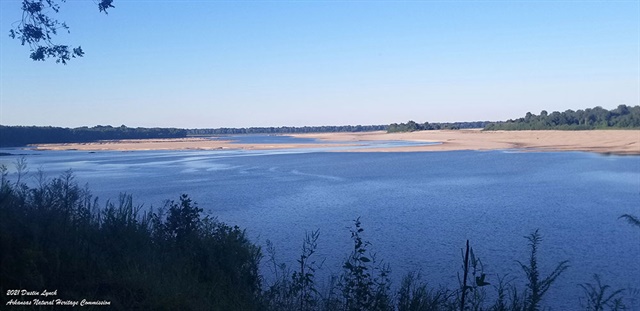
 When I pulled up one of my traps, I found myself face-to-face with an animal that I had never seen before outside of photographs. It was a crustacean about the size of a crayfish, but I knew right away that it was something very different. It had a pair of slender, delicate pincers, which upon closer inspection were at the tips of its greatly elongated second pair of legs, rather than the first. Its body was streamlined and semi-translucent, and its upward-pointing rostrum (“nose”) was covered in a row of prominent saw-like teeth. I knew I was looking at one of the most unique and elusive aquatic species in Arkansas, the Ohio Shrimp (Macrobrachium ohione), which was high on my dwindling bucket-list of aquatic species in Arkansas that I have not yet seen. As I pulled up my other traps, I realized I had actually caught several of these fascinating creatures.
When I pulled up one of my traps, I found myself face-to-face with an animal that I had never seen before outside of photographs. It was a crustacean about the size of a crayfish, but I knew right away that it was something very different. It had a pair of slender, delicate pincers, which upon closer inspection were at the tips of its greatly elongated second pair of legs, rather than the first. Its body was streamlined and semi-translucent, and its upward-pointing rostrum (“nose”) was covered in a row of prominent saw-like teeth. I knew I was looking at one of the most unique and elusive aquatic species in Arkansas, the Ohio Shrimp (Macrobrachium ohione), which was high on my dwindling bucket-list of aquatic species in Arkansas that I have not yet seen. As I pulled up my other traps, I realized I had actually caught several of these fascinating creatures.Arkansas is home to two very distinct species of freshwater shrimp belonging to the family Palaemonidae. Shrimps are decapod (“10-footed”) crustaceans that move primarily by swimming. They have elongated, slender bodies and thin, delicate legs. They differ from the much more commonly encountered crayfish (which belong to a different family of decapods, Cambaridae) in being fully aquatic, having weaker legs used more for perching than walking, having a tail flattened from side-to-side rather than top-to-bottom, and having an overall more slender build.
 Furthermore crayfish and shrimp differ in their primary form of locomotion. While crayfish are capable of swimming in powerful, brief bursts to evade predators, they tend not to travel far using this method, instead preferring to crawl along the bottom with their more well-developed walking legs. Crayfish frequently lose and regrow their chelae (claws), and it is not uncommon to encounter crayfish missing both chelae entirely or with very small, developing claws. There is even a species found in some lowland portions of the state known as the Shrimp Crayfish (Faxonius lancifer) which somewhat resembles a shrimp due to its very small, slim claws and elongated rostrum.
Furthermore crayfish and shrimp differ in their primary form of locomotion. While crayfish are capable of swimming in powerful, brief bursts to evade predators, they tend not to travel far using this method, instead preferring to crawl along the bottom with their more well-developed walking legs. Crayfish frequently lose and regrow their chelae (claws), and it is not uncommon to encounter crayfish missing both chelae entirely or with very small, developing claws. There is even a species found in some lowland portions of the state known as the Shrimp Crayfish (Faxonius lancifer) which somewhat resembles a shrimp due to its very small, slim claws and elongated rostrum. -dustin-lynch.jpg?sfvrsn=de3fb2a4_0&MaxWidth=340&MaxHeight=400&ScaleUp=false&Quality=High&Method=ResizeFitToAreaArguments&Signature=F28E8777077691CCCA8E60B3CE82490709846043) Other crustaceans in Arkansas sometimes mistaken for shrimp are amphipods, commonly known as scuds. Most scuds are extremely small (less than a half-inch in length), strongly laterally compressed, and lack the distinct carapace found in decapods.
Other crustaceans in Arkansas sometimes mistaken for shrimp are amphipods, commonly known as scuds. Most scuds are extremely small (less than a half-inch in length), strongly laterally compressed, and lack the distinct carapace found in decapods. By far, the diminutive Mississippi Grass Shrimp (Palaemonetes kadiakensis) is the most commonly encountered of the two shrimp species in Arkansas, and is found in a variety of aquatic habitats throughout the lowland regions of the state. It can be abundant in the sluggish waters of bayous, sloughs, swamps, backwaters, and oxbows, particularly in areas with ample aquatic vegetation. Grass Shrimps are translucent, sometimes nearly transparent, often with green vegetation visible inside their digestive systems. In gravid females, the tiny eggs are clearly visible through the body wall. The eyes are large and darkly pigmented and the abdomen has a distinctly humped appearance. This species reaches a maximum size of less than 2 inches, although many individuals encountered will be much smaller than that. Grass Shrimps feed primarily on algae but may consume other plant matter and occasionally small aquatic insects and detritus.
By far, the diminutive Mississippi Grass Shrimp (Palaemonetes kadiakensis) is the most commonly encountered of the two shrimp species in Arkansas, and is found in a variety of aquatic habitats throughout the lowland regions of the state. It can be abundant in the sluggish waters of bayous, sloughs, swamps, backwaters, and oxbows, particularly in areas with ample aquatic vegetation. Grass Shrimps are translucent, sometimes nearly transparent, often with green vegetation visible inside their digestive systems. In gravid females, the tiny eggs are clearly visible through the body wall. The eyes are large and darkly pigmented and the abdomen has a distinctly humped appearance. This species reaches a maximum size of less than 2 inches, although many individuals encountered will be much smaller than that. Grass Shrimps feed primarily on algae but may consume other plant matter and occasionally small aquatic insects and detritus.  The much rarer of the two shrimp species in Arkansas is the Ohio Shrimp (Macrobrachium ohione), considered critically imperiled in the state. This species is considerably larger than a Grass Shrimp, attaining a maximum length of more than 4 inches, not counting the length of its appendages, including the prodigiously elongated, pincer-tipped second pair of legs. Females are considerably larger than males. The rostrum of this species is topped with nine to 13 prominent, saw-like teeth (as opposed to the six to eight such teeth present in a Grass Shrimp). It is pale gray in color, flecked with specks of darker pigment. This is a species of our largest rivers, where it can typically be found in side channels or the edges of the main channel.
The much rarer of the two shrimp species in Arkansas is the Ohio Shrimp (Macrobrachium ohione), considered critically imperiled in the state. This species is considerably larger than a Grass Shrimp, attaining a maximum length of more than 4 inches, not counting the length of its appendages, including the prodigiously elongated, pincer-tipped second pair of legs. Females are considerably larger than males. The rostrum of this species is topped with nine to 13 prominent, saw-like teeth (as opposed to the six to eight such teeth present in a Grass Shrimp). It is pale gray in color, flecked with specks of darker pigment. This is a species of our largest rivers, where it can typically be found in side channels or the edges of the main channel. Perhaps the most fascinating thing about the Ohio Shrimp is its complex life history. This species is a long-distance migrant that must travel, often hundreds of miles, from its home in rivers to coastal waters in order to reproduce. Aquatic species that migrate between fresh water and the sea exhibit a life cycle known as diadromy. Diadromy can be further divided into several classifications, the most well-known being anadromy and catadromy. Anadromous species (such as salmon) migrate from the sea into freshwater to spawn, while catadromous species (such as eels) conversely migrate from freshwater to the sea to spawn. The Ohio Shrimp exhibits an even more complicated form of diadromy known as amphidromy, in which adults migrate to the lowest portions of rivers that empty into the ocean to reproduce near the coast. The larvae drift into the marine environment where they spend the first part of their lives growing in coastal waters; in fact, saltwater is necessary for somatic growth in the young of this species. After developing to a certain stage, the juvenile shrimp experience a strong rheotaxis, i.e. a response to the stimulus of a river current in which an organism is compelled to swim upstream. The shrimp then travel sometimes hundreds of miles up rivers to live out their lives far from the coast.
-d-lynch.jpg?sfvrsn=7a226354_0&MaxWidth=340&MaxHeight=400&ScaleUp=false&Quality=High&Method=ResizeFitToAreaArguments&Signature=8511DE734A124085331A2F8B8AE1F07522056352) At one time, the Ohio Shrimp could be found throughout most of the eastern United States. It could be found in the Mississippi River basin from the Gulf Coast to the upper reaches of the Ohio River, and also in rivers along the southern Atlantic coast. The species was historically so abundant throughout much of the Mississippi River that it supported inland commercial shrimping industries in several states, where it was collected both for bait and human consumption, a practice that still persists in a few areas. Although historical accounts of the species in Arkansas are somewhat scarce, there is evidence that it once ranged as far up the Arkansas River as Fort Smith and may have been found throughout much of the Red River as well.
At one time, the Ohio Shrimp could be found throughout most of the eastern United States. It could be found in the Mississippi River basin from the Gulf Coast to the upper reaches of the Ohio River, and also in rivers along the southern Atlantic coast. The species was historically so abundant throughout much of the Mississippi River that it supported inland commercial shrimping industries in several states, where it was collected both for bait and human consumption, a practice that still persists in a few areas. Although historical accounts of the species in Arkansas are somewhat scarce, there is evidence that it once ranged as far up the Arkansas River as Fort Smith and may have been found throughout much of the Red River as well. Unfortunately, the Ohio Shrimp has drastically declined across much of its historic range, vanishing entirely from many of the rivers it once inhabited. The main culprit is the same that has contributed to the decline of most migratory aquatic species – the construction of dams and other barriers that impede the ability to migrate and complete their life cycles. In Arkansas, outside of the Mississippi River itself, the Ohio Shrimp is now thought to be confined to the lower reaches of a handful of direct tributaries such as the White and St. Francis rivers. Further habitat modification of large rivers, including alteration and maintenance of navigation channels, has also negatively impacted the species. During migration, Ohio Shrimp utilize main channel borders that are heavily impacted by such modifications. The species may further be impacted by other factors such as historic over-exploitation, pollution, and the introduction of non-native species.
The Ohio Shrimp is an all but forgotten piece of the aquatic natural heritage of Arkansas. The loss of this species from much of its former range is a sad tale, but there is hope to be taken from its quiet, continued persistence in the state’s largest and most iconic river, where it continues to carry out the same remarkable journey to the sea, year after year, that it has for millennia.

Photos:
Photo 1 — Ohio Shrimp (Macrobrachium ohione) from the Mississippi River. Photo by Dustin Lynch.
Photo 2 — Shrimp Crayfish (Faxonius lancifer) from Benson Creek Natural Area in Monroe and Woodruff counties. Photo by Dustin Lynch.
Photo 3 — Scud (Amphipod) from Rattlesnake Ridge Natural Area in Pulaski County. Photo by Dustin Lynch.
Photo 4 — Mississippi Grass Shrimp (Palaemonetes kadiakensis) from Lorance Creek Natural Area in Pulaski and Saline counties. Photo by Dustin Lynch.
Photo 5 — Ohio Shrimp (Macrobrachium ohione) from the Mississippi River. Photo by Dustin Lynch.
Photo 6 (and main photo) — Ohio Shrimp (Macrobrachium ohione) from the Mississippi River. Photo by Dustin Lynch.
Photo 7 — Mississippi River at Choctaw Island Wildlife Management Area. Photo by Dustin Lynch.
Photo 1 — Ohio Shrimp (Macrobrachium ohione) from the Mississippi River. Photo by Dustin Lynch.
Photo 2 — Shrimp Crayfish (Faxonius lancifer) from Benson Creek Natural Area in Monroe and Woodruff counties. Photo by Dustin Lynch.
Photo 3 — Scud (Amphipod) from Rattlesnake Ridge Natural Area in Pulaski County. Photo by Dustin Lynch.
Photo 4 — Mississippi Grass Shrimp (Palaemonetes kadiakensis) from Lorance Creek Natural Area in Pulaski and Saline counties. Photo by Dustin Lynch.
Photo 5 — Ohio Shrimp (Macrobrachium ohione) from the Mississippi River. Photo by Dustin Lynch.
Photo 6 (and main photo) — Ohio Shrimp (Macrobrachium ohione) from the Mississippi River. Photo by Dustin Lynch.
Photo 7 — Mississippi River at Choctaw Island Wildlife Management Area. Photo by Dustin Lynch.
-d-lynch.jpg?sfvrsn=7a226354_0&MaxWidth=510&MaxHeight=300&ScaleUp=false&Quality=High&Method=ResizeFitToAreaArguments&Signature=583E7164D1C4B2D8CD5FE94BDA664132C39F2325)